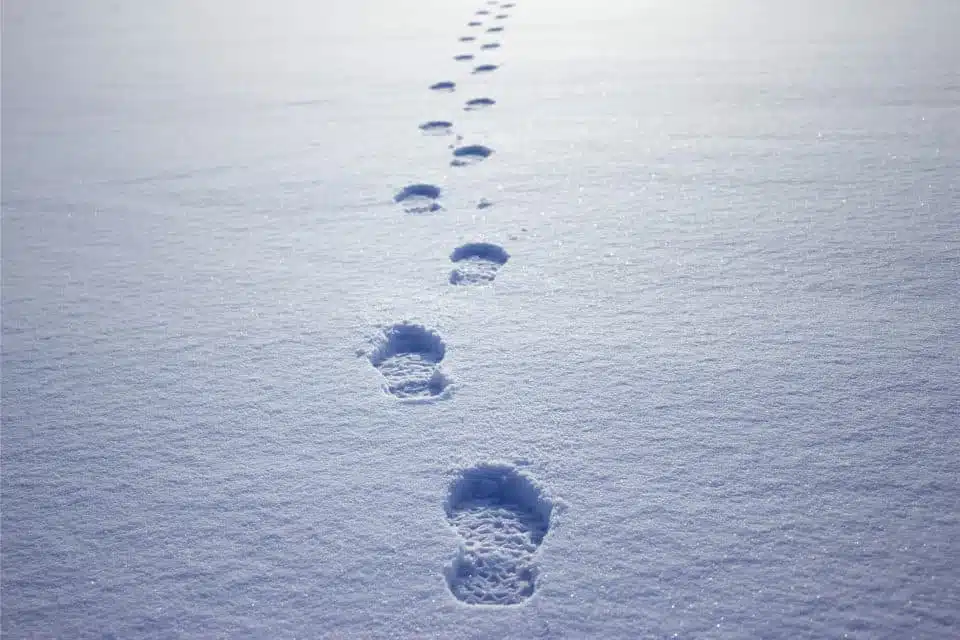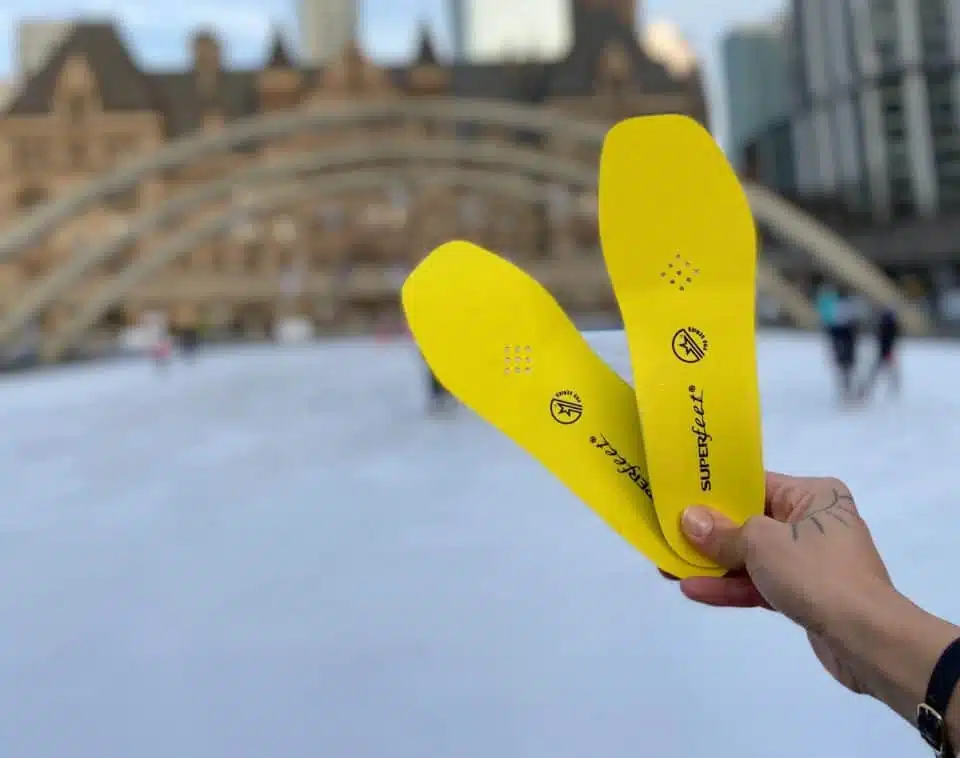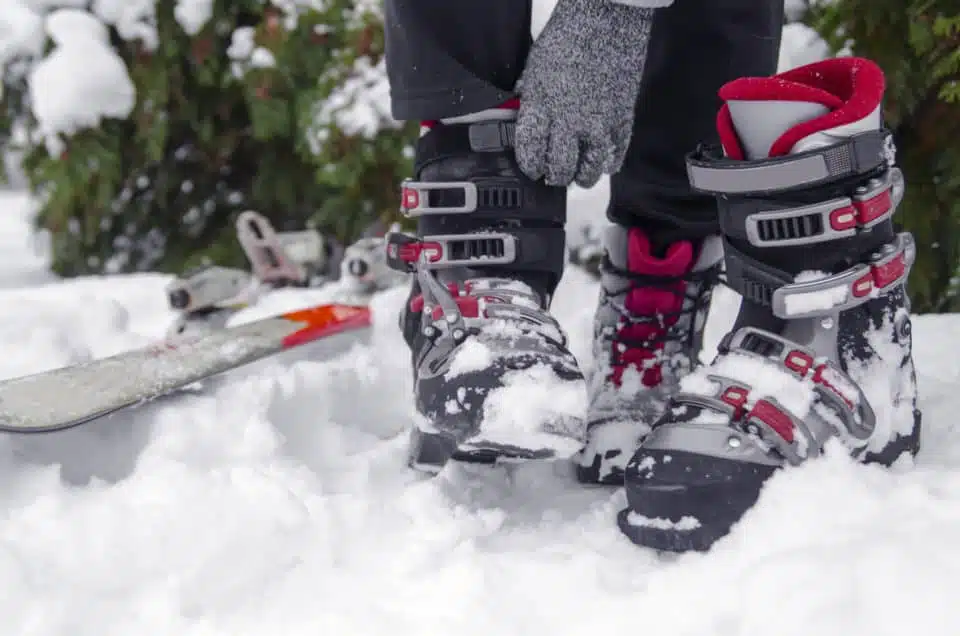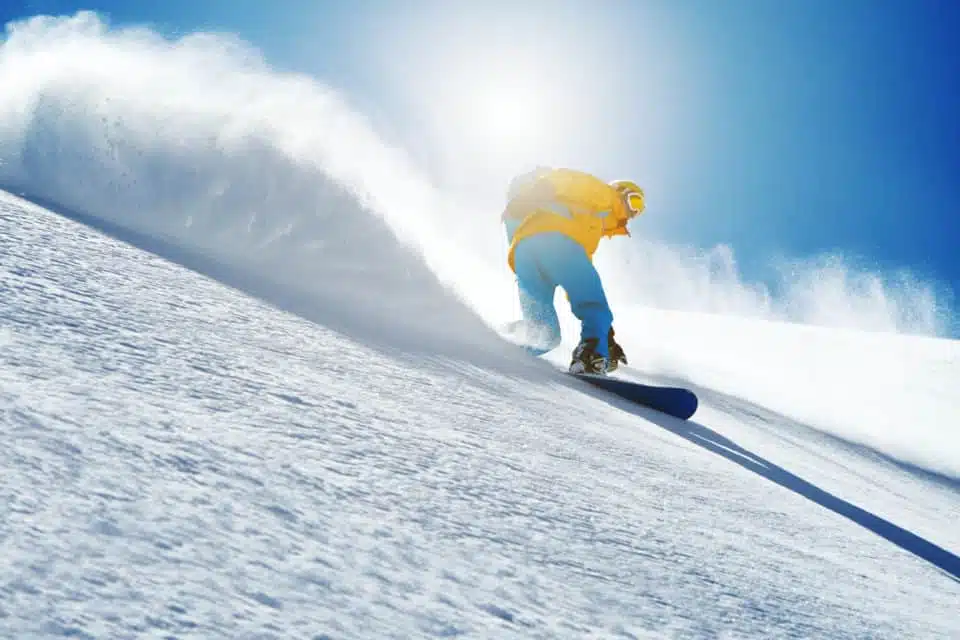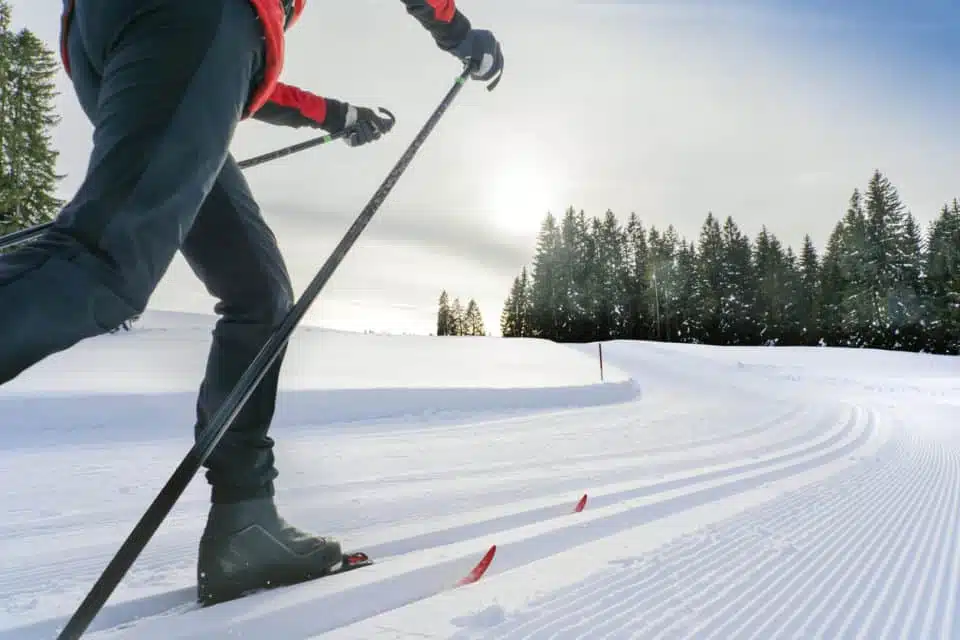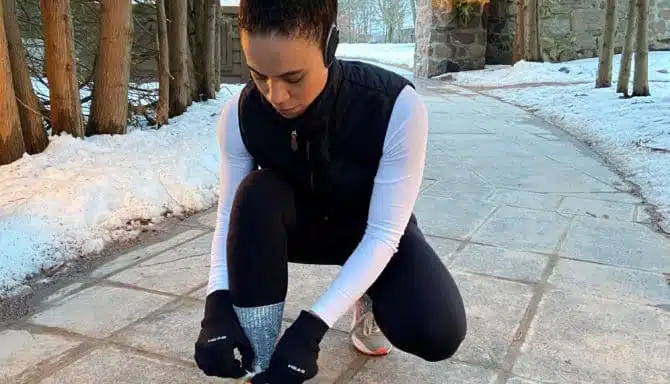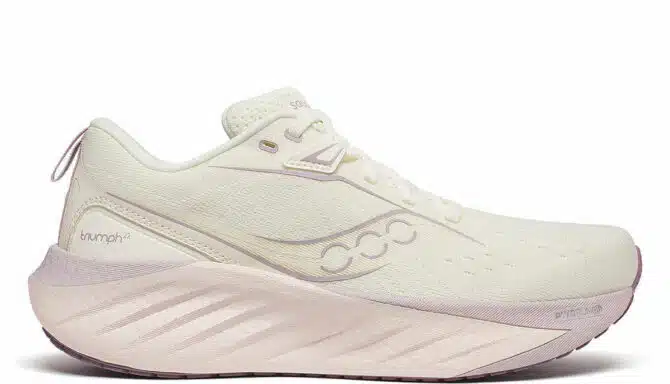Winter sports are synonymous with Canada. The fact that it’s cold and snowy out for 4-5 months of the year means winter sports are extremely popular both as avenues of fitness and a pastime. Using winter sports to stay active during the cold winter months will promote good foot health so you can keep up with your fitness goals – and have fun while you do it! Staying active is also one of the best ways to keep your feet healthy (and for our overall health too).
Above all, there are four sports that are particularly popular:
These four sports all are unique in that they require specialized equipment, and specifically footwear. In this article, we’ll explain the mechanics of each sport, what to do when choosing footwear, as well as common foot conditions to consider when partaking in each winter sport.
Ice hockey
Ice hockey is Canada’s national winter sport. From youth to adults, hockey is a popular form of exercise. As an extension, ice skating is also quite popular – you get just the skating portion, without the need for a hockey stick. Here in Toronto, there are plenty of ice rinks to play leisurely hockey. Additionally, there are public spots to skate like Union Station, Nathan Phillips Square, the Bentway, Harbourfront Centre Rink, College Park, and Grenadier Ice Pond.
Ice skates
Ice skates are footwear with a single blade affixed to the sole. A proper fit for hockey skates should fit 1-1.5 sizes smaller than your street shoes. Your toes should barely touch the end of the toe box while having no more than 1/4 inch of space in the heel. Skates that are too big result in blisters and a noticeable decrease in skating ability due to a lack of ankle stability. Skates that are too small cramp the toes and put the foot under considerable pressure with each stride. The tightness of the boot leads to a loss of circulation, limiting the function of the foot.
Common ice hockey and skating foot conditions
- Athlete’s foot: Fungi love warm, moist environments, such as communal showers, locker rooms and around public swimming pools. We recommend wearing flip-flops or shoes in these places so that your skin won’t come into contact with any infected surfaces.
- Blisters: Skates that are too big can cause blisters as the friction caused by your moving foot can damage the skin.
- Foot odour: Hockey skates are notorious for creating foot odour. The fact that they sit in your hockey bag between uses, and are cool, moist places, means fungi thrive. Use antiperspirant powder, and ensure you properly dry your skates between uses.
- Plantar fasciitis: Those who play hockey may develop plantar fasciitis because of the stiffness and lack of support of hockey skates. Plantar fasciitis is a common foot condition that causes your plantar fascia (the connective tissue that runs between your toes and heel) to become inflamed and irritated. This results in severe heel pain. If you feel as though your skates lack the proper arch support, Superfeet makes a skate-specific insole called the Superfeet CARBON Pro Hockey insoles.
Downhill skiing
Downhill skiing is one of the most popular winter sports. Here in Toronto, there is great access to downhill skiing both in southern Ontario as well as in upstate New York or in Vermont. Common ski destinations include Blue Mountain Resort, Holiday Valley Ski Resort, Mount Louis Moonstone, Bristol Mountain, Greek Peak Mountain Resort, Horseshoe Resort, and Hockley Valley Resort. Downhill skiing is typically best done between December and March when there is adequate snow.
Ski boots
When it comes to downhill skiing foot care, the most important consideration is ski boot fit. Ski boots fit differently than your regular footwear. Properly fitted ski boots are the single most important factor for skiing. (They fit differently than regular footwear.) Modern alpine ski boots have rigid soles and attach to the ski at both toe and heel using a spring-loaded binding.
Downhill (also known as alpine) ski boots fit snug, with your toes touching the end of the ski boot, but not to the point of being cramped. Ski boot sizing also varies from your regular shoe size. Downhill ski boots use what’s called the Mondopoint sizing system. This is a measure of your feet in centimetres. The tighter the fit, the more control you will have over your skis. This creates the possibility for pressure points and pain, so finding your exact size is important. If the boot is too big, your toes have too much wiggle room, and will likely cause blisters. If the boot is too tight, it may reduce circulation (which will make your feet colder), and also cause blisters because of cramping.
It’s important to note that ski boots only come in full-size increments (24.5, 25.5, 26.5, etc.). You can achieve a half-size fit but technically the boot is identical to the full-size up or down. The half-size is achieved by using a thicker inner shell.
One final consideration is arch support. Ski boots don’t have great built-in insoles so over-the-counter insoles like Superfeet provide a cost-effective and comfortable solution for when you’re on skis.
Common skiing foot conditions
- Frostbite: ski conditions are often cold, and you can be outside for hours on end. Prolonged exposure to cold puts your feet at risk of frostnip or frostbite. Invest in a quality pair of socks (like Merino wool) that both wick moisture away from your feet, and stay warm.
- Athlete’s foot: Fungi thrive in dark moist areas and feed on keratin – a primary component of the epidermis (the outer layer of human skin). This means that our feet, which spend most of the day bound up in socks and shoes, present an ideal environment for the proliferation of a fungal infection. Athlete’s foot thrives on damp socks or tight-fitting footwear, especially those made of non-breathable materials. Another word of caution: if you’re renting equipment, beware of possible fungus. Shared rentals can be ripe with the type of fungus that causes athlete’s foot and toenail fungus. These conditions stem from dark, warm, and moist environments – in other words, the exact kind of environment of ski boots. To reduce your risk of foot fungus, rub your feet with antiperspirant before skiing to keep your feet dry, and do a proper wash of your feet afterwards.
- Blisters: With boots too tight, blisters will form where there is continuous pressure. If the boots are too loose, blisters and chafing will occur where rubbing takes place, usually at the heel and sides of the feet. Additionally, excessive sweat build-up promotes ski boot blisters and chafing.
- Discoloured toenails: If your boots are too tight, you run the risk of damaging your toenail. Discoloured toenails are caused by trauma to the toenail. It may start out as a reddish-purple colour and then gradually change to black. This can be due to major trauma, such as dropping something on your toe, or repetitive minor traumas, such as exercising in shoes that are too small. The black colour typically comes from bruising or blood beneath the nail.
Snowboarding
Ever since its introduction in the 1960s, snowboarding has become increasingly popular, with skiers and snowboarders now sharing the slopes. Like skateboarding, the feet are loosely bound perpendicular to the board. Generally, the chance of injury to the lower body is less in snowboarding than it is in skiing.
In snowboarding, your feet do not release if you fall, whereas with skiing your skis detach. The mechanical support provided by the feet being locked to the snowboard has the effect of reducing the likelihood of knee injury – 15% of snowboard injuries are to the knee, compared with 45% of all skiing injuries. However, upper body injuries (like to your torso, or wrists), are much higher amongst snowboarders.
Still, snowboarders are prone to injury to their feet and legs – specifically sprains, which account for around 40% of injuries.
Snowboard boots
Snowboard boots are built dissimilarly from ski boots. They’re much less rigid, more comfortable, and provide greater flexibility.
Snowboard boot sizing is very similar to street shoe sizing except it’s much more important to get right. Your feet should be comfortably snug within your boots without having any pinches or pokes that can cause poor circulation. Your toes should be able to wiggle slightly but not be able to move forward or backwards. Buying boots that are a little snug is a good idea because boots tend to loosen with time and can open up some space after a while. Additionally, snowboard boots are often laced. This means you can customize the fit (or lacing system) like you can with your shoes.
Snowboard boots don’t need as snug a fit because your feet are strapped into the board. This means you’re less likely to need boots that may be tighter-fitting.
Common snowboarding foot conditions
- Frostbite: like with skiing, frostbite, and frostnip are common foot conditions experienced by snowboarders. Pack a warm pair of socks, or use toe warmers for added heat.
- Athlete’s foot
- Blisters: With boots too tight, blisters will form where there is continuous pressure. If the boots are too loose, blisters and chafing will occur where rubbing takes place, usually at the heel and sides of the feet. Additionally, excessive sweat build-up promotes snowboard boot blisters and chafing.
- Foot odour
- Twisted ankles: snowboarder’s ankle. Fractures of the talus bone are rare in other sports but account for 2% of snowboard injuries – a lateral process talus fracture is sometimes called “snowboarder’s ankle” by medical staff.
Cross-country skiing
Cross-country ski boots are fortunately less like ski boots and more like bicycle shoes. Downhill ski boots are heavier, stiffer, and have a higher cuff, whereas cross-country ski boots are lighter, have a lower cuff, and are more flexible as the attachment system is built differently.
Generally, cross-country skiing is great for your fitness, as it’s a full-body workout. As with running in winter, proper stretching is vital before cross-country skiing. In cross-country skiing, the heel goes up and down constantly. Without properly loosening up first, the motion can result in painful Achilles tendinitis and plantar fasciitis, among other problems.
Common cross-country skiing foot conditions
- Frostbite
- Athlete’s foot
- Blisters
- Foot odour
- Achilles tendonitis: Because the heel is not locked into place with cross-country skiing, the Achilles heel is more prone to aggravation. Achilles tendonitis is a painful condition that occurs when the Achilles tendon (the tendon at the back of the ankle that connects your heel to your calf) becomes inflamed. It is characterized by pain and swelling above the back of the heel when running or walking. As it progresses, it can make climbing stairs, or any movement involving the foot and ankle, very difficult.
